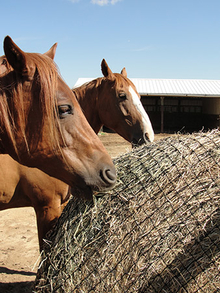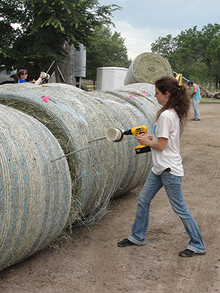Quick facts
- Good quality hay provides ample nutrients to meet the needs of most horses.
- Regardless of the class of horse, forages should make up at least 50% of the daily ration.
- Optimizing forages in your horse's diet will result in a healthier horse and can help reduce costs.
The horse’s digestive tract is designed to use forage as the main diet component. Horses have simple stomachs and hindguts that aid in fiber digestion. Horses eat small frequent meals throughout the day. When pasture is unavailable or when stalling horses, you can feed hay to meet their nutritional needs.
How much hay should you feed?
Feed your horse based on its nutritional needs, which include digestible energy, carbohydrates, fats, amino acids, minerals, vitamins and water. Your horse’s individual nutritional needs depend on its age, metabolism, weight, maintenance, growth, exercise and whether it is pregnant or lactating.
Most classes of horse can meet all or most of their energy needs from quality hay alone. However, hay alone may not be enough for growing, reproducing or exercising horses. For more information on determining your horse’s nutritional needs, refer to the National Research Council’s Nutrient Requirements of the Horse.
- Horses require at least 1% of their body weight in roughage such as hay or fresh forage each day.
- When given free access to hay, horses will willingly eat 2 to 2.5% of their body weight in hay daily.
- Most horses should consume 2% of their body weight in hay each day.
The amount and type of hay a horse needs ultimately depends on the individual horse's nutrient requirements and the quality of the hay. The best way to determine hay quality is through laboratory testing.
Correctly using forage in your horse’s diet
You can meet the nutrient needs of an adult, idle horse through good quality grass hay alone.
Feeding program for a 1,000-pound, idle adult horse
- Required daily feed intake: 2% of the horse’s body weight
- Total daily intake: 20 pounds of feed
- Percent of hay in daily ration: 100%
- Percent of concentrate in daily ration: 0%
- Daily amount of hay: 20 pounds
Always have your hay laboratory-tested to identify any nutrient deficiencies. Often, hays are low in some vitamins and minerals and you’ll need to supplement them. Most commercial feed companies offer a vitamin and mineral supplement that’s low in digestible energy and complements the nutrient content of forages. These are commonly called ration balancers.
The nutrient needs of a working horse change with the intensity and duration of exercise. Exercise will increase your horse’s nutrient needs. Consider changing hay types before adding grain to your horse’s diet.
- Plant species and maturity affect the nutrient content of hay.
- Compared to grass, alfalfa is higher in digestible energy and other nutrients like amino acids and calcium.
- A less mature forage will be more nutrient-dense than a mature forage.
- Switching hay types can help you better match the nutrient needs of your horse.
Alfalfa hay may be sufficient in meeting the needs of working horses, particularly horses in light or moderate exercise.
Heavy and very heavy exercise will likely require you to include a cereal grain-based concentrate in your horse’s daily ration. However, forage should make up at least 50 percent of the daily ration.
Feeding program for a moderately exercised, 1,000-pound horse
Moderate exercise refers to horses working three to five hours per week.
- Required daily feed intake: 2% of the horse’s body weight
- Total daily intake: 20 pounds of feed
- Percent of hay in daily ration: 75%
- Percent of concentrate in ration: 25%
- Daily amount of hay: 15 pounds
- Daily amount of concentrate: 5 pounds
Age and growth rate greatly affect the energy and nutrient needs for growing horses. For young horses in training (18 to 24 months of age), intensity of exercise also affects their nutritional needs.
You can use good quality grass hay and grass-alfalfa mixed hays in feeding programs for young, growing horses. If you feed a large amount of alfalfa, make sure the calcium to phosphorus ratio of the diet is about three to one and never inverted.
Young horses with increased nutrient needs (from training or exercise) will need more concentrates, but forage should make up at least 50% of the diet.
Example of a feeding program for a 12-month-old, 700-pound horse
- Average daily gain: 1 pound
- Required daily feed intake: 2% of the horse’s body weight
- Total daily intake: 14 pounds of feed
- Percent of hay in ration: 75%
- Percent of concentrate in ration: 25%
- Daily amount of hay: 10.5 pounds
- Daily amount of concentrate: 3.5 pounds
- National Academies of Science, Engineering and Medicine
Reviewed in 2023



